Introduction to Canvas
Canvas is a writing tool that empowers content creation with AI assistance and contextual notes. Craft informed, engaging content effortlessly.
Canvas at a glance
Canvas is a writing tool that combines human creativity with artificial intelligence (AI) assistance. It helps you create well-informed content by grounding AI suggestions in your specific project context.
Canvas is designed around two key principles:
- Context is king: Attach relevant notes, research, and guidelines to your document. Canvas grounds your writing in the specific context of your project.
Read more about notes - AI as collaborator: Canvas' built-in AI functions as an intelligent co-author. It leverages large language models while staying anchored in the context you provide.
Read more about the embedded AI
Canvas helps you produce high-quality work more efficiently. Whether you're drafting a blog post, crafting product copy, or assembling a comprehensive report, Canvas supports your writing process.
Feature walk-through video

To get started you can watch a short video introducing the most important features, or get into the documentation by taking a tour of the Canvas interface, or keep on reading to get your hands dirty straight away with a practical example.
Quickstart Example – Drafting a blog post
In this follow-along example you'll be writing a blog post with some select travel advice for spud aficionados.
- Go to the Canvas app in your organization dashboard and create a new document (Help). Title it "The best travel destinations for potato lovers".
- Start off by making a note. Notes are where you keep all your research, contextual information and other supporting material. In the notes panel on the left side, find the button labeled Create your first note and click it.
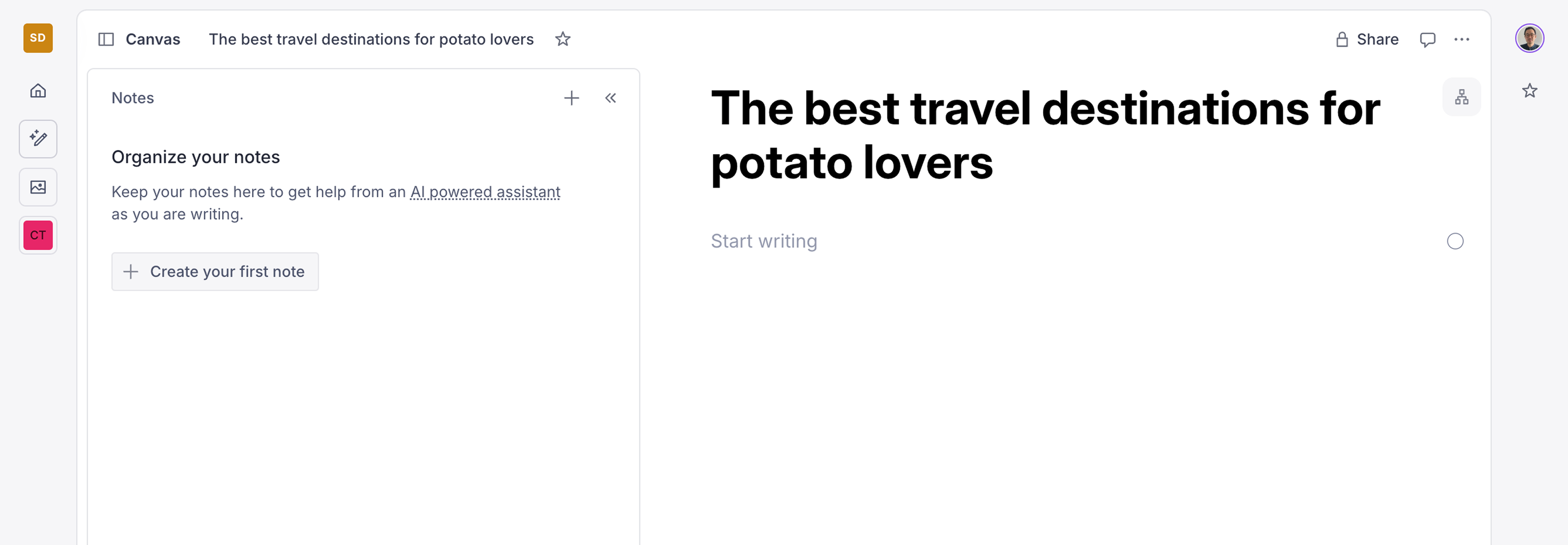
- To start off with some solid information, paste this list of potato museums around the world into your note. The AI assistant will draw from your notes when making suggestions.
# List of potato museums
## Austria
Waldviertler Erdäpfelwelt (Waldviertler potato world) is a museum with interactive displays located in the town hall of Schweiggers displaying the history and uses of potatoes to the present day.
## Belgium
Musée vivant de la pomme de terre ("Living Museum of the Potato") in Genappe is part of the Wallonia Botanical Gardens and also houses a collection of onions from northern Europe.
Frietmuseum in Bruges is dedicated to chips (or fries in American-English) and is located in one of Bruges' oldest buildings, dated
## Canada
The Canadian Potato Museum in O'Leary, Prince Edward Island, claims to contain the world's largest collection of potato artifacts. It is also home to a Potato Hall of Fame. A 14-foot (4.3 m) high giant potato made of fiberglass stands at the entrance and visitors can learn about the origins of the wild potato up to modern-day agricultural practices.
Potato World is a museum dedicated to the potato. It is located in Florenceville-Bristol,New Brunswick, known as the french fry capital of the world.
## Denmark
Danmarks Kartoffelmuseum ("Danish Potato Museum") in Otterup is part of the Hofmansgave estate. The Hofmansgaves were responsible for popularising the potato in Denmark where potatoes were known as "German lumps".
## France
Moulin Gentrey in Harsault (fr) is a former starch mill dating from 1870 which contains a small potato museum as part of a historical tour of starch making for the textile industry.
## Germany
Deutsches Kartoffelmuseum ("German Potato Museum") in Fußgönheim (de) is housed in a former synagogue next to the Fußgönheim Agricultural Museum. The museum dates from 1987.Das Kartoffelmuseum ("The Potato Museum") in Munich dates from 1996 and is run by the Otto Eckart Foundation on behalf of Pfanni GmbH, a division of Unilever.Vorpommersches Kartoffelmuseum ("Potato Museum of Vorpommern") in Tribsees (de)
## Italy
Museo della patata ("Potato Museum") in Budrio
## Lithuania
There is a Bulvės muziejus ("Potato Museum") in Kudirkos Naumiestis, near the border with Kaliningrad.
## United States
Potato Museum in Albuquerque, New Mexico, was originally housed in the basement of E. Thomas and Meredith Hughes' basement in Washington, D.C., before moving to Albuquerque in 1993. It began in 1975 and is a nonprofit organization.Idaho Potato Museum is in Blackfoot, Idaho, and among the exhibits has the world's largest potato chip (crisp in British-English), a Pringle measuring 25 inches (64 cm)- Doing so, you'll notice that the Canvas AI has helpfully named our note and classified it as a Fact. If your result was different, bring up the note category menu and change it to Fact.
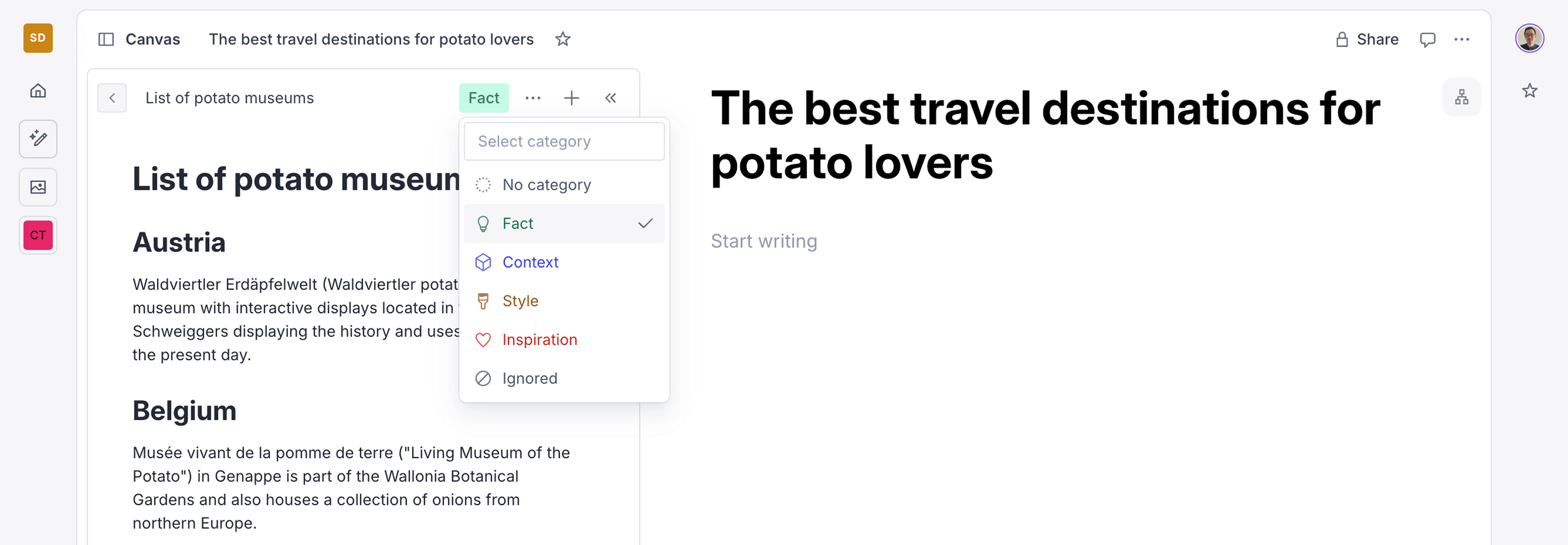
- Before moving on to the document editor to do some writing, create one more note with some context for the task at hand. Once again, click Create note in the side panel on the left, and paste the following into it:
We are writing a blog post featuring exciting destinations for potato-aficionados.
This will inform the AI assistant about your goal and intention, which in turn will enable it to make better suggestions. Make sure this new note is classified as Context.
- With your notes ready, move your focus to the document editor. The blank editor provides space for your content. Use the AI assistant to generate content.
- Enter the following: "Write an outline for a blog post featuring 3 of the best travelling destinations for potato lovers".
- With your cursor positioned at the end of the sentence, hit CMD-ENTER (CTRL-ENTER on Windows). This converts the sentence into an instruction for the AI assistant.
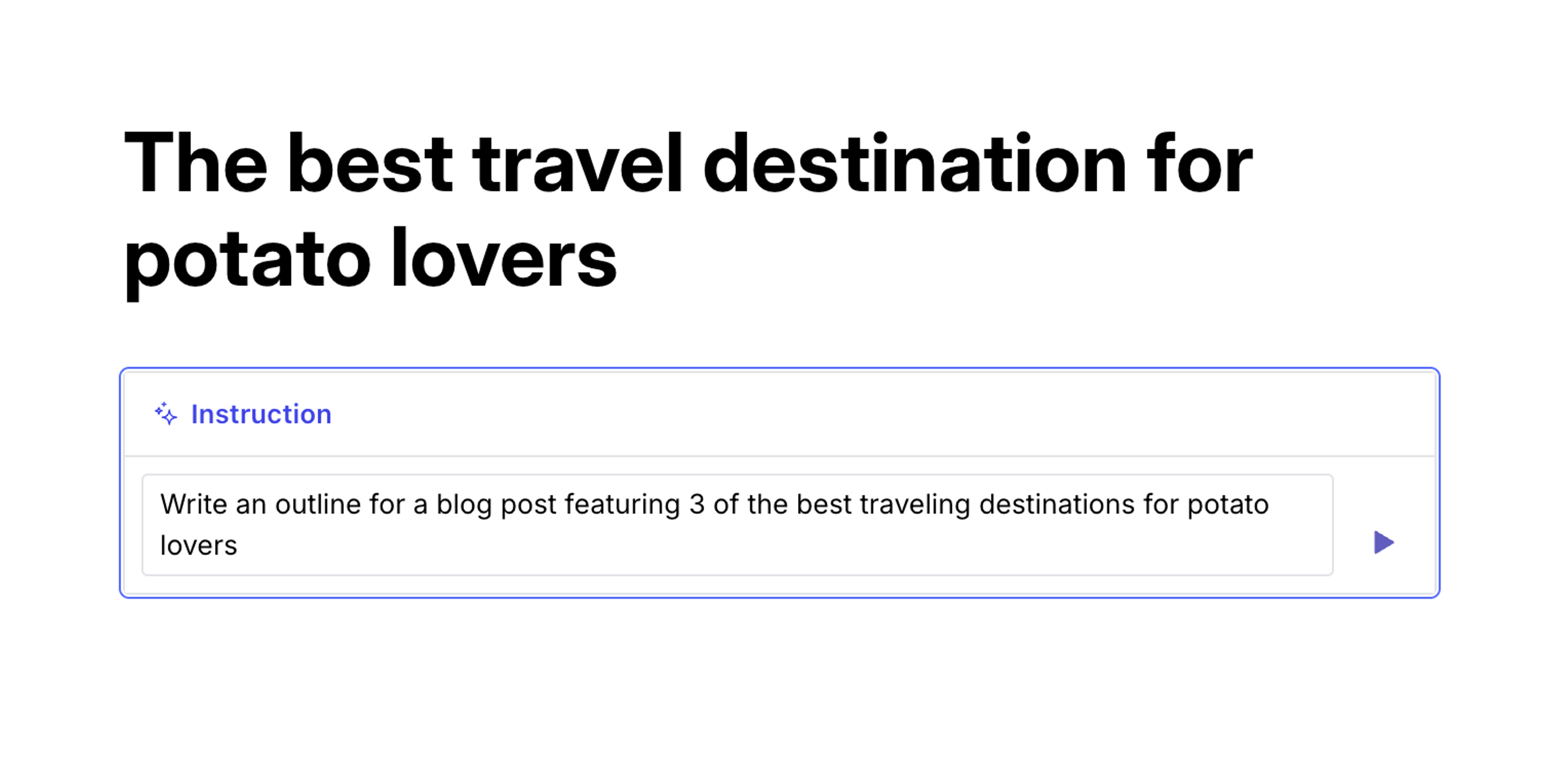
Protip
You can also create a new instruction by hitting the slash key / on an empty line. Slash commands are discussed in greater details further on in this article!
- The assistant is now primed with task context and source information. It should produce a solid first draft. You can accept the changes or refine the instruction. Adjust as needed to improve the output.
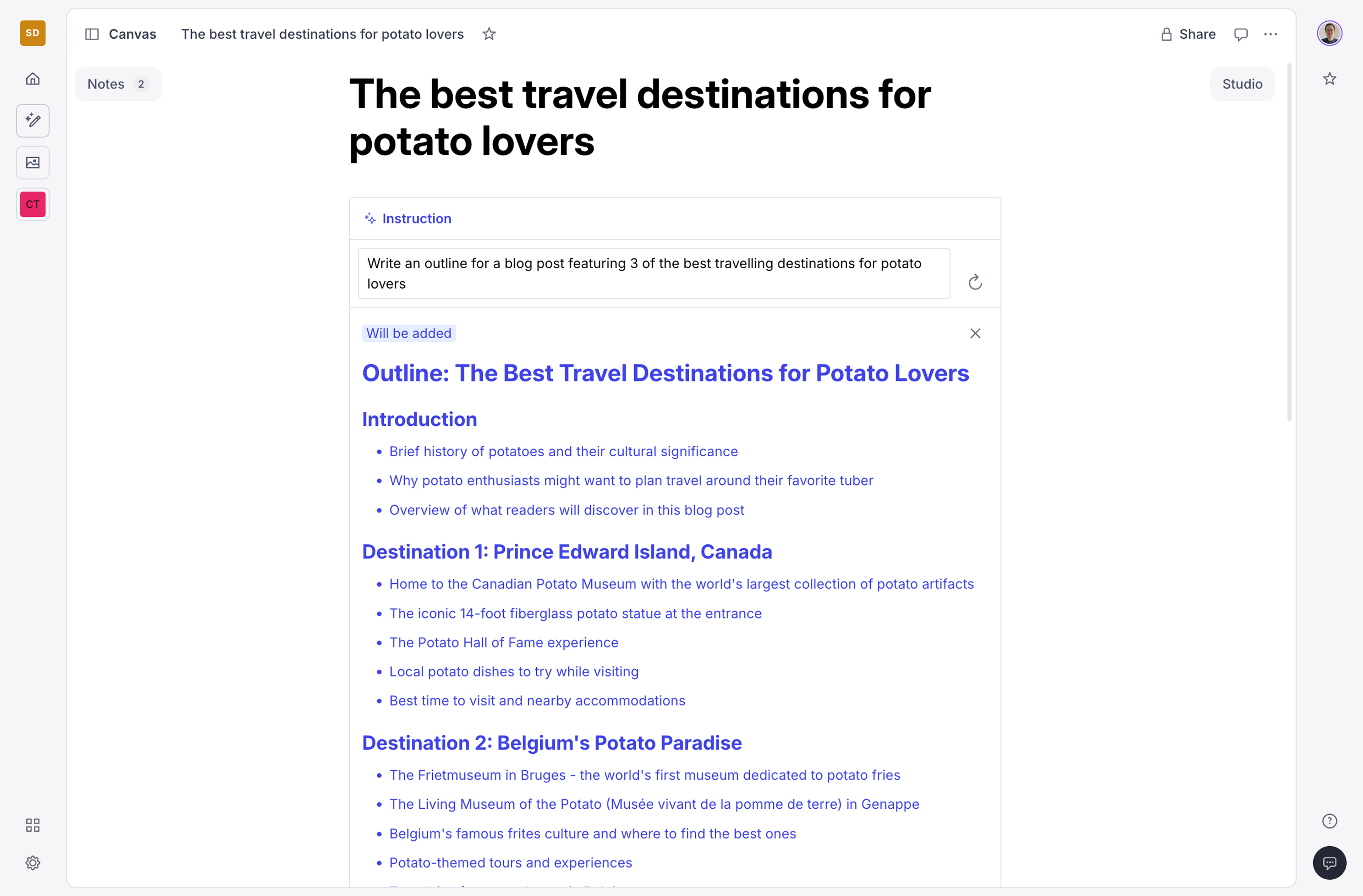
- After accepting or discarding the assistant's output, place your cursor at the end of a paragraph. Notice the subtle circle icon that follows your cursor. This is the AI contextual menu, known as "the Blip". Click the icon.
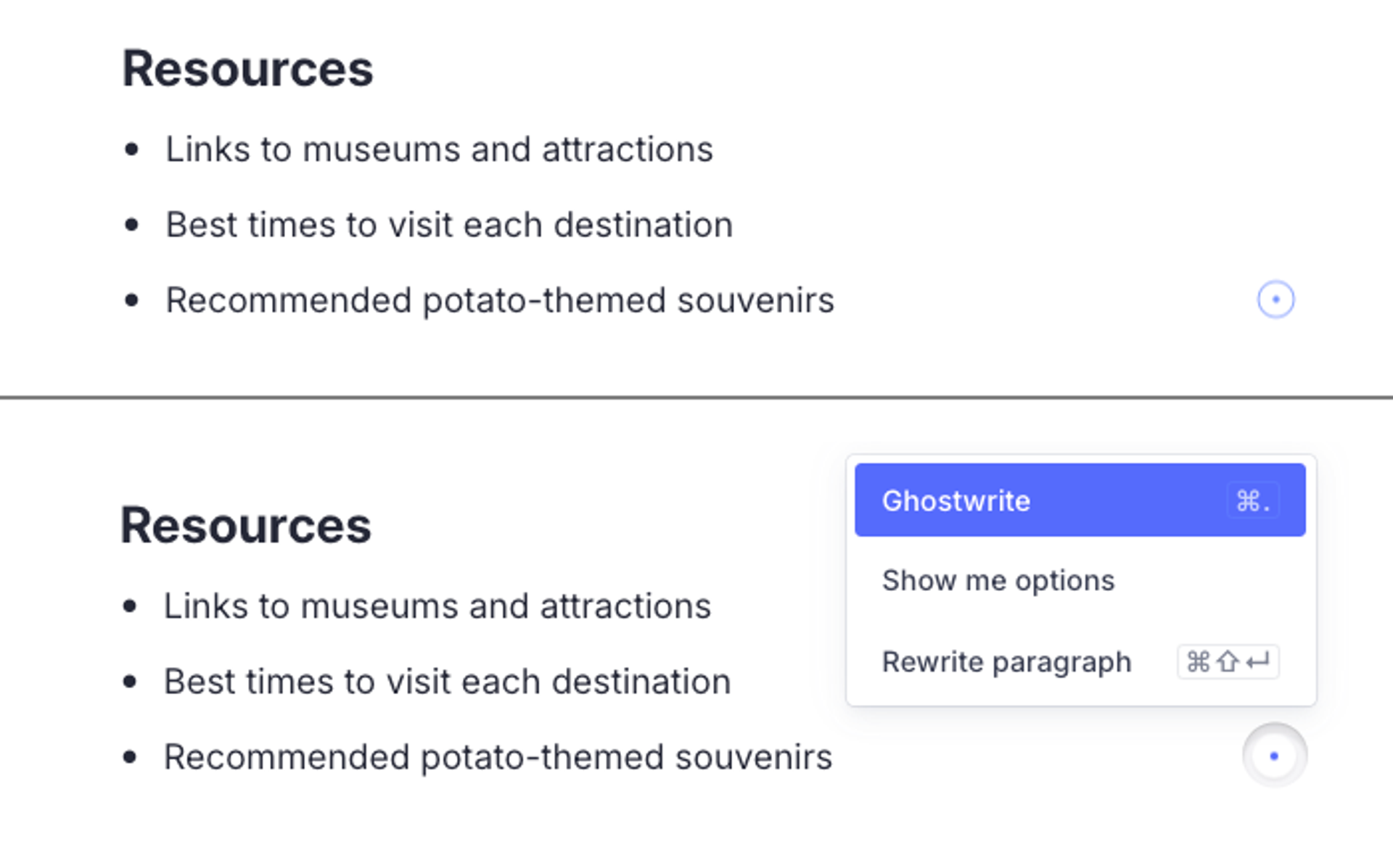
- You'll be presented with a few options for interacting with the AI capabilities of Canvas.
- Ghostwrite instructs the assistant to continue writing. Press TAB after each sentence to continue.
- Show me options will instruct the assistant to suggest a few different ways to proceed.
- Rewrite paragraph will tell the assistant to do another take on the current paragraph.
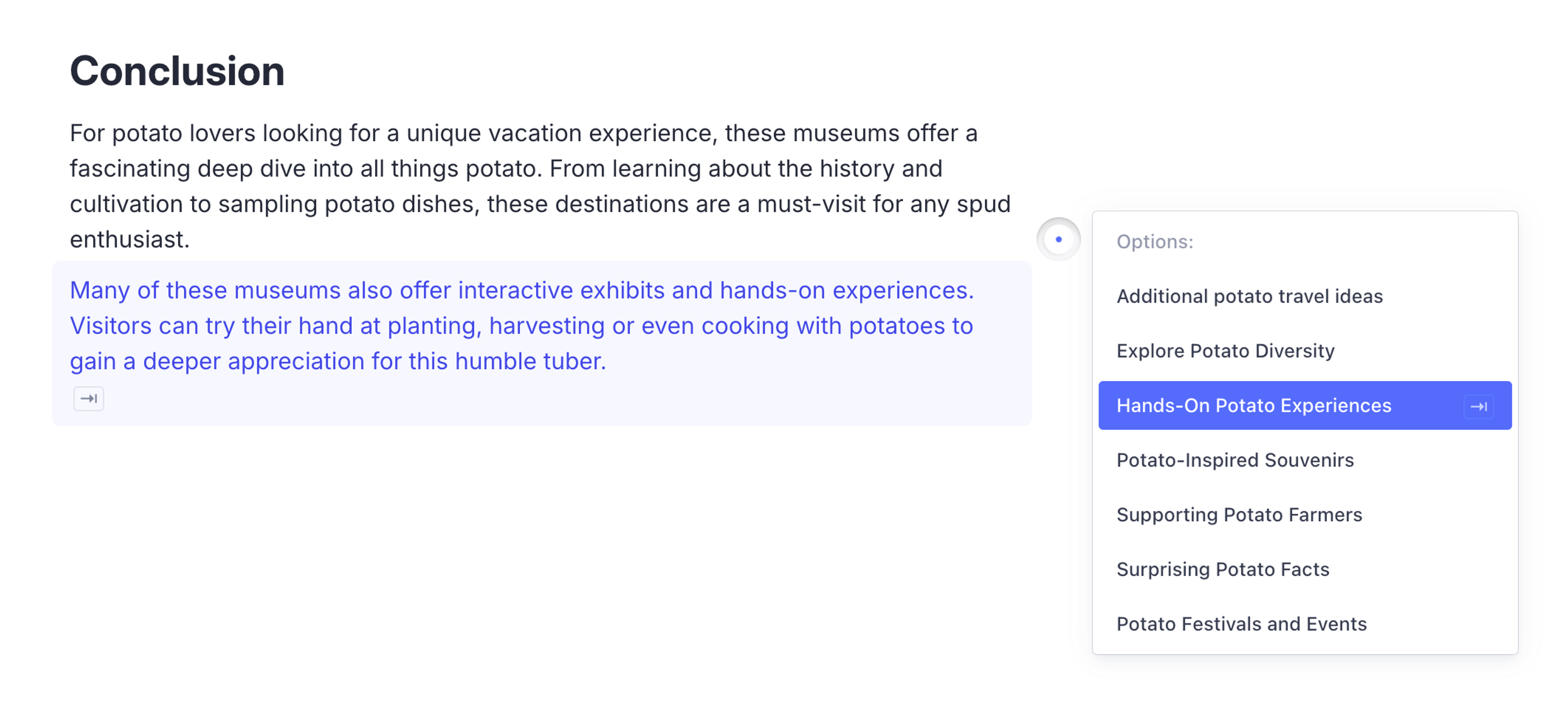
Next steps:
- Experiment with notes:
- Try to add a Style note to influence the tone of the blog post.
- Find a great piece of prose and add it as Inspiration.
- Read more about notes
- Keep exploring the AI capabilities:
- Ask the AI to give you some different options on how to proceed.
- Use
CMD + .(command period) to start the AI ghostwriter. Hit tab to continue once it pauses. - Read more about AI
- Read the article on Content Mapping to learn about linking your Canvas documents to your Sanity Studio.
- Read on to learn more about Canvas.
Touring the Canvas interface
Documents
Documents are the core conceptual unit of Canvas. The document editor is where your work is done, providing a familiar, minimalist writing environment for you to craft your content, while the document sidebar is where you'll find all your existing notes, as well as notes shared with you by others and templates for new documents. Here's what you need to know about working with documents in Canvas:
Finding your documents
You can browse through all your existing documents with some helpful filters by opening the left sidebar. This is also where you'll find any templates created by you or other people in your organization. Templates are helpful starting points for new documents.
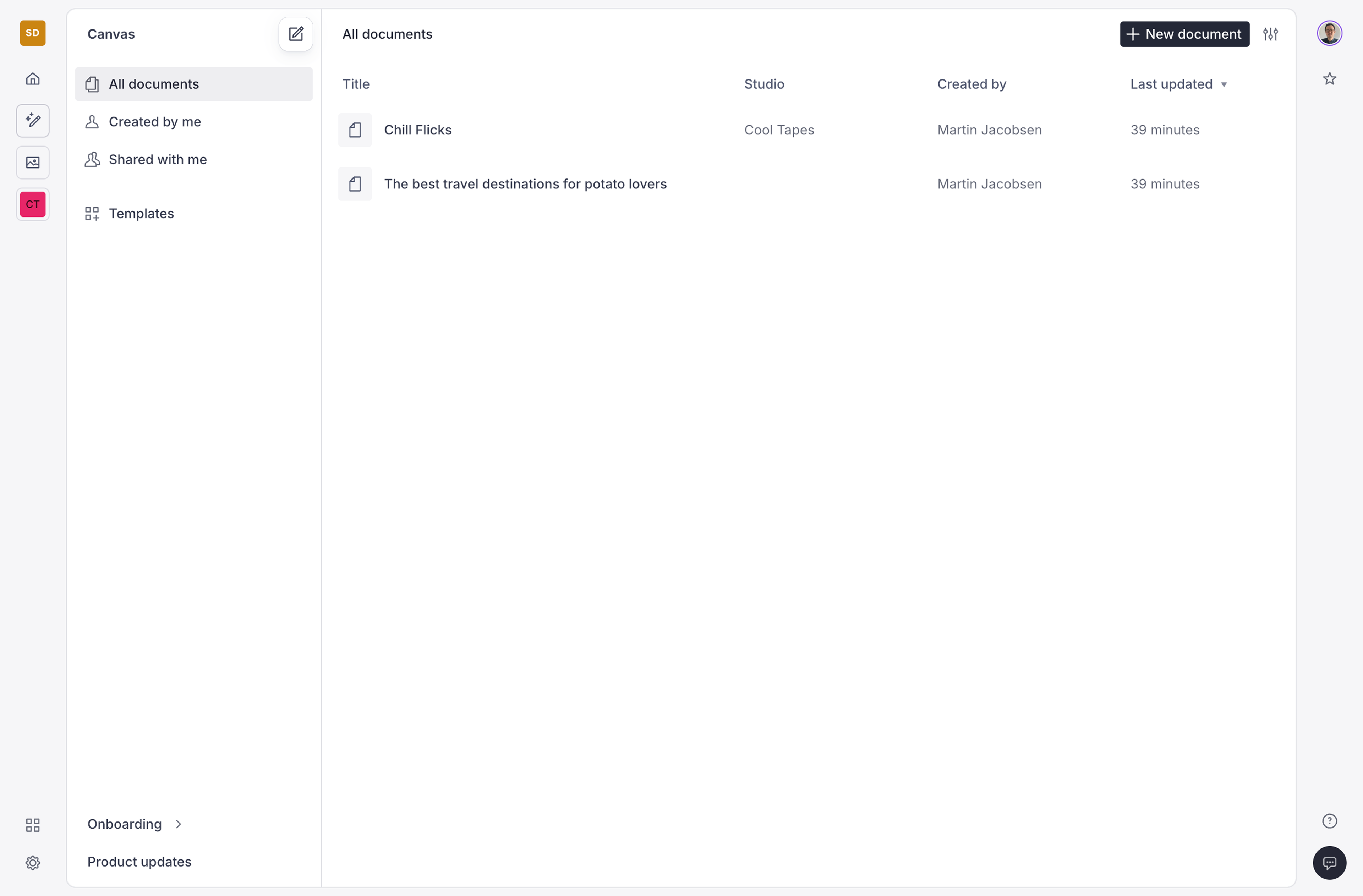
Creating a new document
You can quickly create a new document from either the sidebar or from within the document browser.
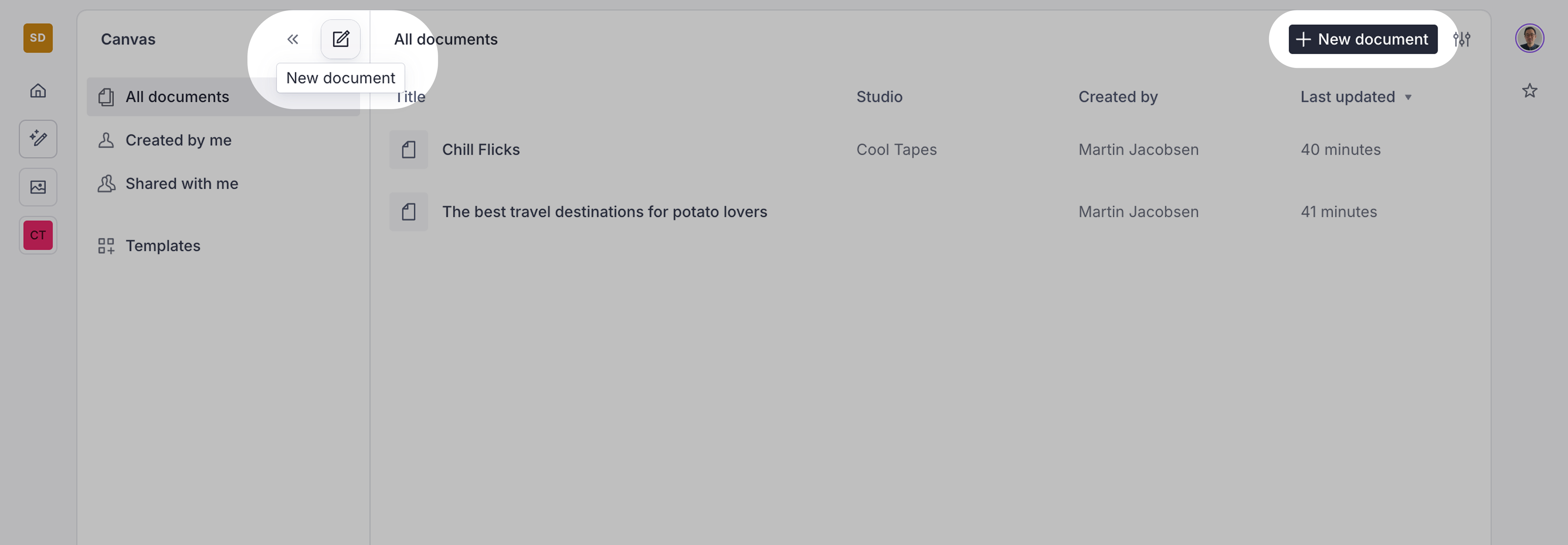
Deleting documents
If you need to remove a document, you can do so from within the document editor view. Click the ellipsis menu in the top right corner, and then click delete. Note that this action is permanent, so be sure you truly want to delete the document before confirming.

The document editor
Canvas offers a clean, distraction-free writing environment that will feel instantly familiar to anyone who has used a modern word processor or text editor. The interface is designed to put your content front and center, allowing you to focus on getting your thoughts down without any clutter or unnecessary features getting in the way.

Slash commands and Markdown formatting
The writing space in Canvas supports a range of formatting options to help you structure and style your content. You can use familiar slash commands to quickly apply headings, lists, quotes, and more without taking your hands off the keyboard.
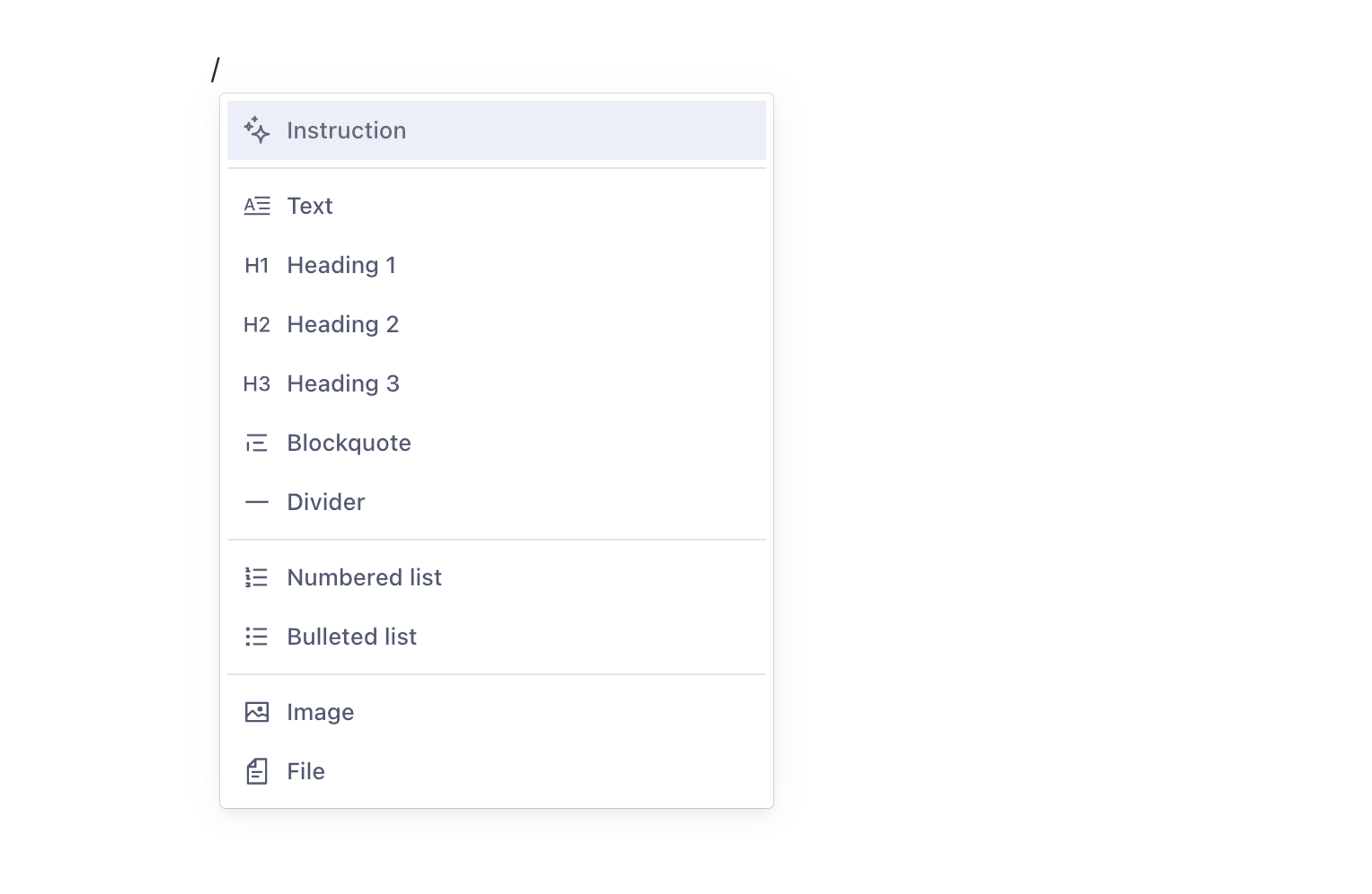
In addition to slash commands, Canvas also supports a subset of standard Markdown syntax for formatting text. You can use hyphens or numbers to make lists, and hash symbols to denote headings. For those who prefer a more visual approach, basic formatting options like bold, italic, and underline are also available via buttons in a popover whenever text is selected.

Whether you prefer slash commands, Markdown, or the toolbar, Canvas aims to make formatting your document quick, intuitive, and distraction-free. The goal is to let you focus on your writing while still having easy access to the tools you need to make your content clear, scannable, and visually appealing.
Keyboard shortcuts
Essentials
- Ctrl/Cmd+C – Copy
- Ctrl/Cmd+X – Cut
- Ctrl/Cmd+V – Paste
- Ctrl/Cmd+Shift+V – Paste without formatting
- Ctrl/Cmd+Z – Undo
- Ctrl/Cmd+Shift+Z – Redo
Formatting
- Ctrl/Cmd+B – Bold
- Ctrl/Cmd+I – Italic
- Ctrl/Cmd+U – Underline
- Ctrl/Cmd+Shift+X – Strikethrough
- Ctrl/Cmd+E – Inline code
- Ctrl/Cmd+K – Insert/Edit link
- Ctrl/Cmd+Shift+M – Insert comment
Notes
Every writer knows that behind every polished piece of prose lies a mountain of notes, research, and insights that inform and guide the work, but never see the light of day in the final draft. Canvas is a writing tool that not only acknowledges, but celebrates and elevates this often unseen but essential part of the process.
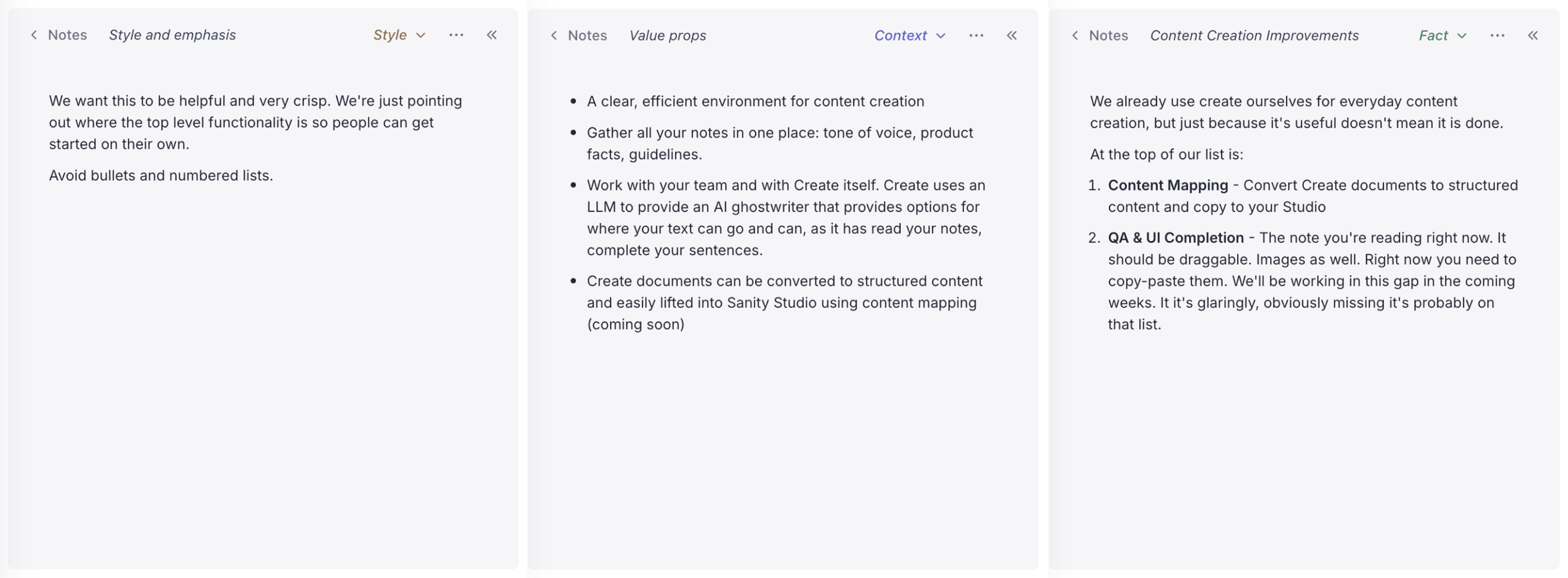
Notes are a key feature in Canvas that provide context, facts, style guidelines, and inspiration to inform your writing and enable the built-in AI co-writer to make relevant and informed suggestions. By attaching relevant notes to your document, you give the AI the background knowledge and topical awareness it needs to be of actual help.
Show or hide the notes side panel
Your notes live in the side panel to the left of your main content editing area. If you don't see the side panel it might have been closed when someone needed to unclutter a bit. If this is the case you can open the side panel by clicking the button labeled Notes in the left sidebar area.
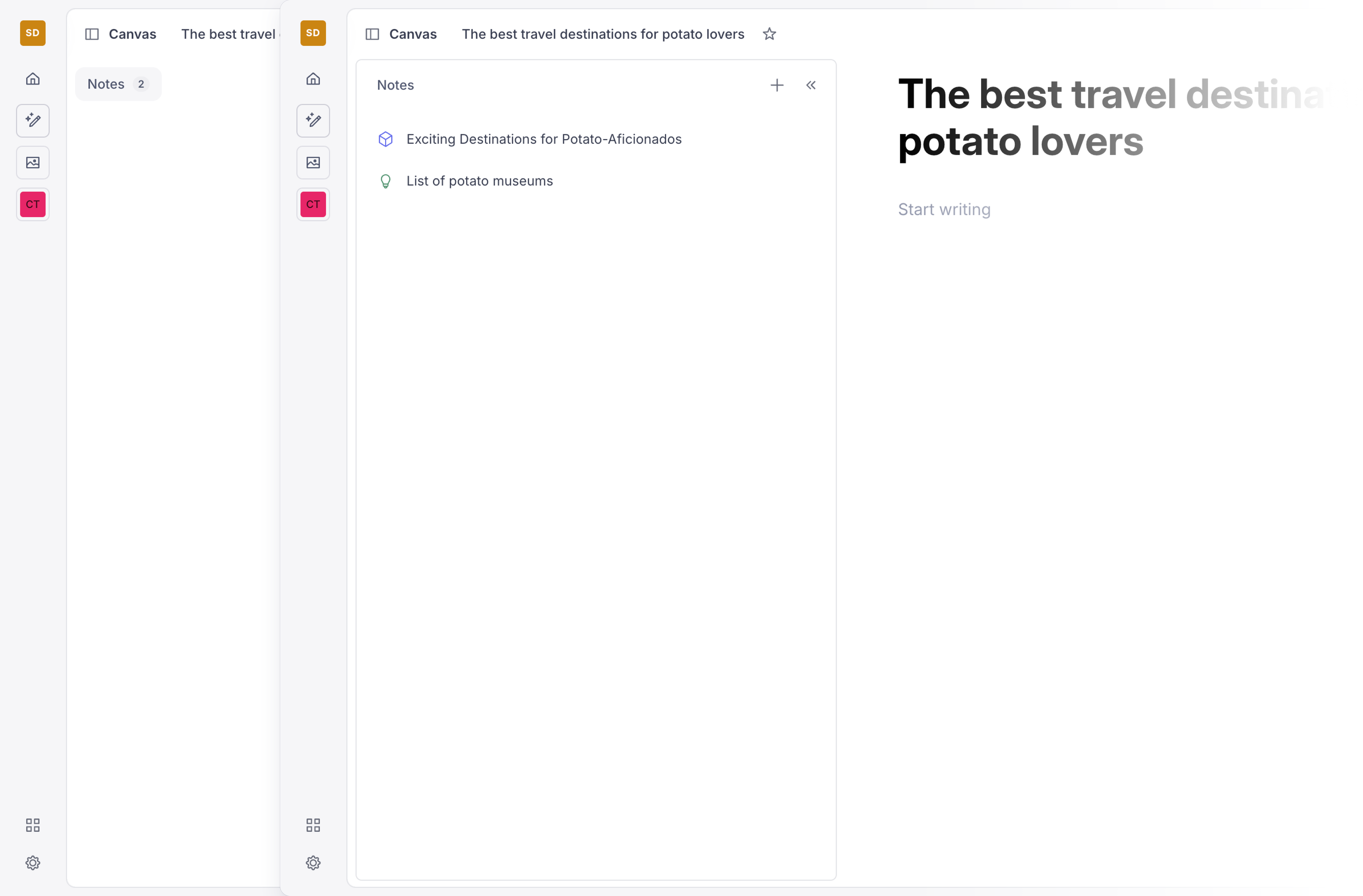
To resize the side panel, or hide it altogether, grab the divider between the sidebar and main editor area and drag it all the way to the left to hide the side panel, or resize it to your liking. Clicking the divider will also toggle between hiding or showing the side bar.

Creating notes
To create a note, click the button with a + icon at the very top of the notes panel. You might proceed give your note a title and select a category, or just start writing. You can add content to your note in the form of text, images, URLs, or even PDF files. Canvas will do its best to determine the type of note (as will be discussed in the next section) and generate a suitable title. You can, of course, override the AI's suggestions in either case.
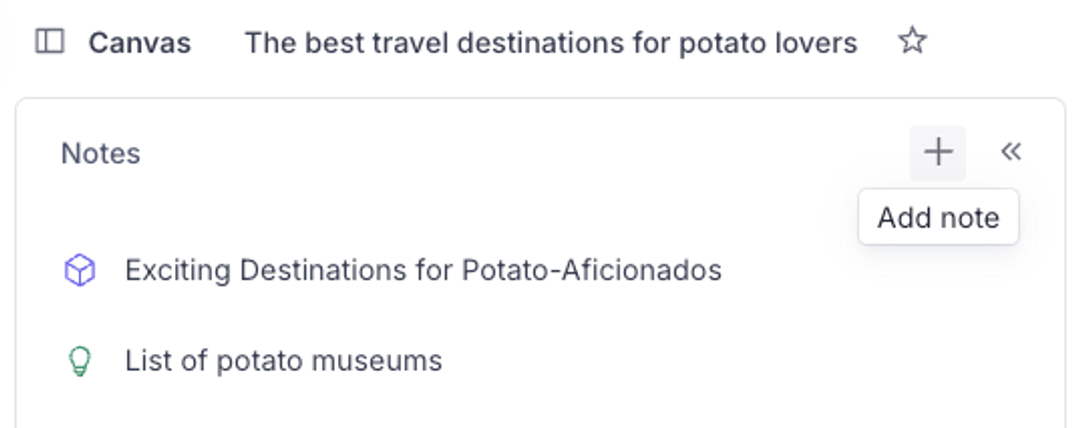
Different notes for different goals
Canvas offers four distinct types of note, each serving a different purpose:
- Context Notes: Provide high-level background information and framing for the document, such as project briefs, target audience details, or internal enablement material.
- Fact Notes: Contain specific data points, quotes, or pieces of information that should be treated as factual and incorporated into the content where relevant.
- Style Notes: Outline the desired voice, tone, and stylistic guidelines for the document, ensuring the ghostwriter adopts the appropriate tone and style for the piece.
- Inspiration Notes: Collect examples, analogies, or creative prompts to inspire the writing and infuse it with engaging elements.The AI assistant uses these notes to gain a deep understanding of the project at hand and tailor its suggestions accordingly.
How notes inform the AI assistant
When you provide notes, the AI uses this information to guide its content generation. Context notes help the AI understand the big picture and overall purpose of the document. Fact notes ensure accuracy by providing specific data points to incorporate. Style notes allow the AI to adopt the appropriate voice and tone for the piece. And inspiration notes give the AI creative fodder to draw from, helping to make the writing more engaging and colorful.
Protip
When the AI receives contradictory information in your notes, the note that is located the highest in the side panel is the one that takes presedence. Top notes beat bottom notes.
In essence, notes allow you to have a "conversation" with the ghostwriter, providing it with the knowledge and direction it needs to be a truly useful writing assistant. The more relevant and specific the notes you provide, the better the ghostwriter can tailor its output to your needs. So take the time to curate your notes carefully - it will pay off in the quality of the content Canvas helps you produce.
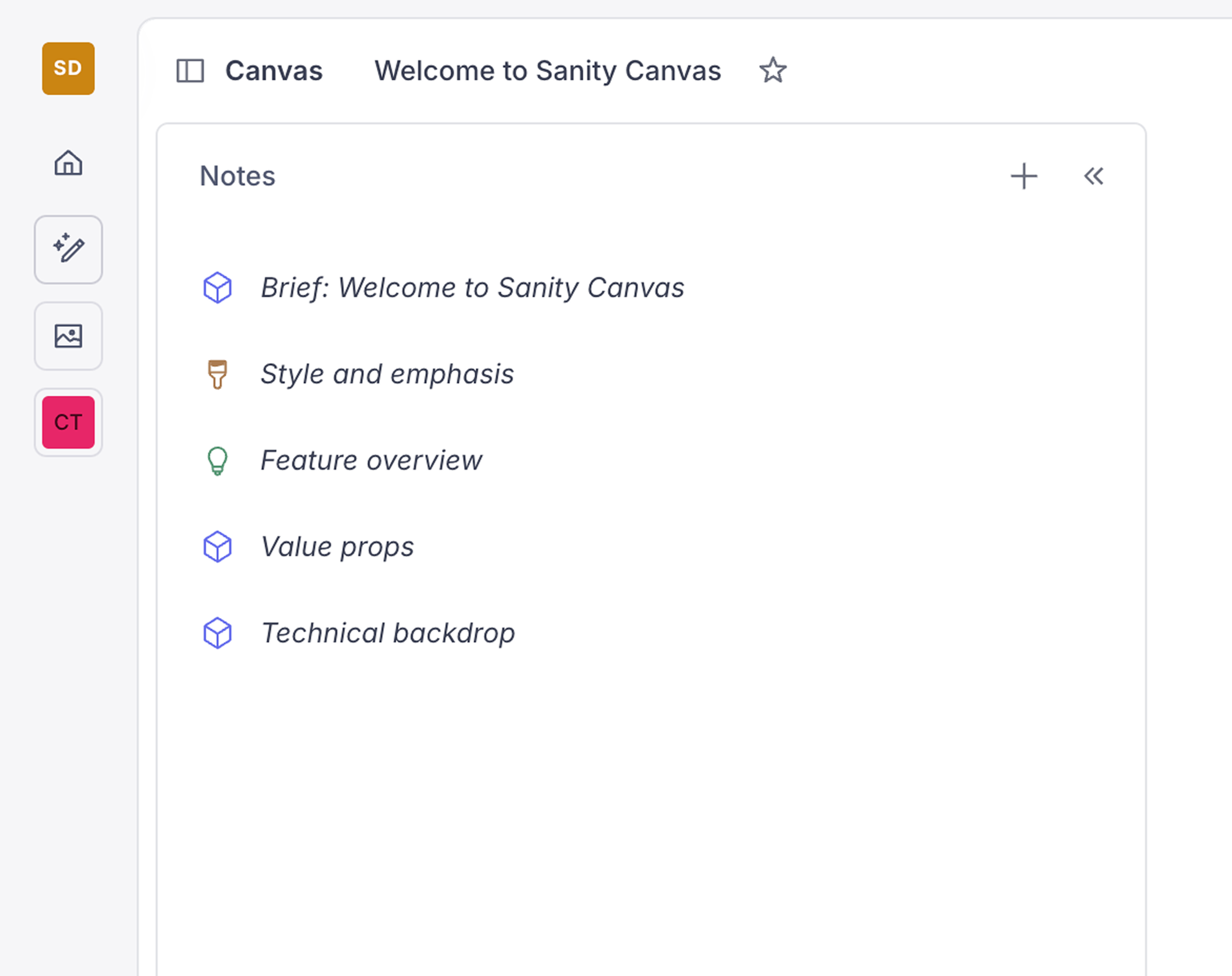
Note actions
Moving, renaming, duplicating, and deleting notes
Move and re-arrange notes by dragging them directly in the notes panel. Right clicking any note in the list will open a contextual menu that will reveal additional options, including those to either duplicate or delete a specific note.
Once a note has been selected, rename it by clicking the title or alternatively do this in each note's dedicated context menu, located in the top right of each selected note.
AI ghostwriter
Canvas' built-in AI writing assistant is more than just a text generator. It's an informed collaborator that leverages the power of Large Language Models (LLMs) while staying grounded in the specific context of your project. By feeding the AI relevant notes, research, and guidelines, you transform it from a mere automaton into an insightful co-author capable of producing content that aligns with your unique needs and objectives.
What sets the Canvas AI apart is its ability to understand and utilize the notes you provide. Whether it's high-level context about the project's goals, specific facts to incorporate, stylistic guidelines to follow, or creative inspiration to draw from, the AI takes it all into account when generating suggestions. This means the content it produces is not only fluent and coherent but also relevant and tailored to your project.
Think of the AI as your brainstorming partner. It can help you flesh out ideas, expand on sections, and even polish your writing to ensure it hits the right tone and style. But it's not a replacement for your own insights and expertise. The key is to use the AI as a tool to enhance and accelerate your writing process, not to fully automate it.
By combining the efficiency of AI with the directed context of your notes, Canvas empowers you to craft content that is both deeply informed and compellingly written. It's a new way of working that puts you in control while harnessing the power of artificial intelligence to boost your productivity and creativity as a writer.
Capabilities
- Generating new content based on your notes and existing text
- Expanding on ideas and fleshing out sections
- Refining and polishing your writing
- Adapting to the style and tone specified in your notes
- Incorporating facts and inspiration from your notes
Meet the Blip – How to use the AI assistant
The AI assistant in Canvas can be interacted with in a number of ways, but the most readily apparent is the subtle circle icon that follows you around the document, affectionally known as "the Blip".

Clicking the Blip will open a menu of different instructions to run in the context of your current position in the document.
Ghostwrite
The Ghostwrite option is your go-to for generating new content or expanding on existing ideas. When you select this option, the AI assistant will analyze your current position in the document, along with any relevant notes and surrounding context, to suggest a continuation of your writing.Depending on where your cursor is placed, the AI may suggest completing the current sentence, starting a new paragraph, or even beginning a new section with a relevant heading. The goal is to provide a seamless and contextually appropriate continuation that flows naturally from your existing content.
Show options
Show options presents you with a range of alternative suggestions for how to continue your writing. When you click this option, the AI will generate multiple possible paths forward based on your current context and notes.These options might include different ways to complete the current thought, introduce a new idea, or transition to a related topic. By offering a variety of suggestions, the AI allows you to explore different creative directions and choose the one that best fits your vision.

Rewrite paragraph
This option will instruct the assistant to do another take on the current paragraph. You will be given the opportunity to give the assistant a short brief on what you'd like.
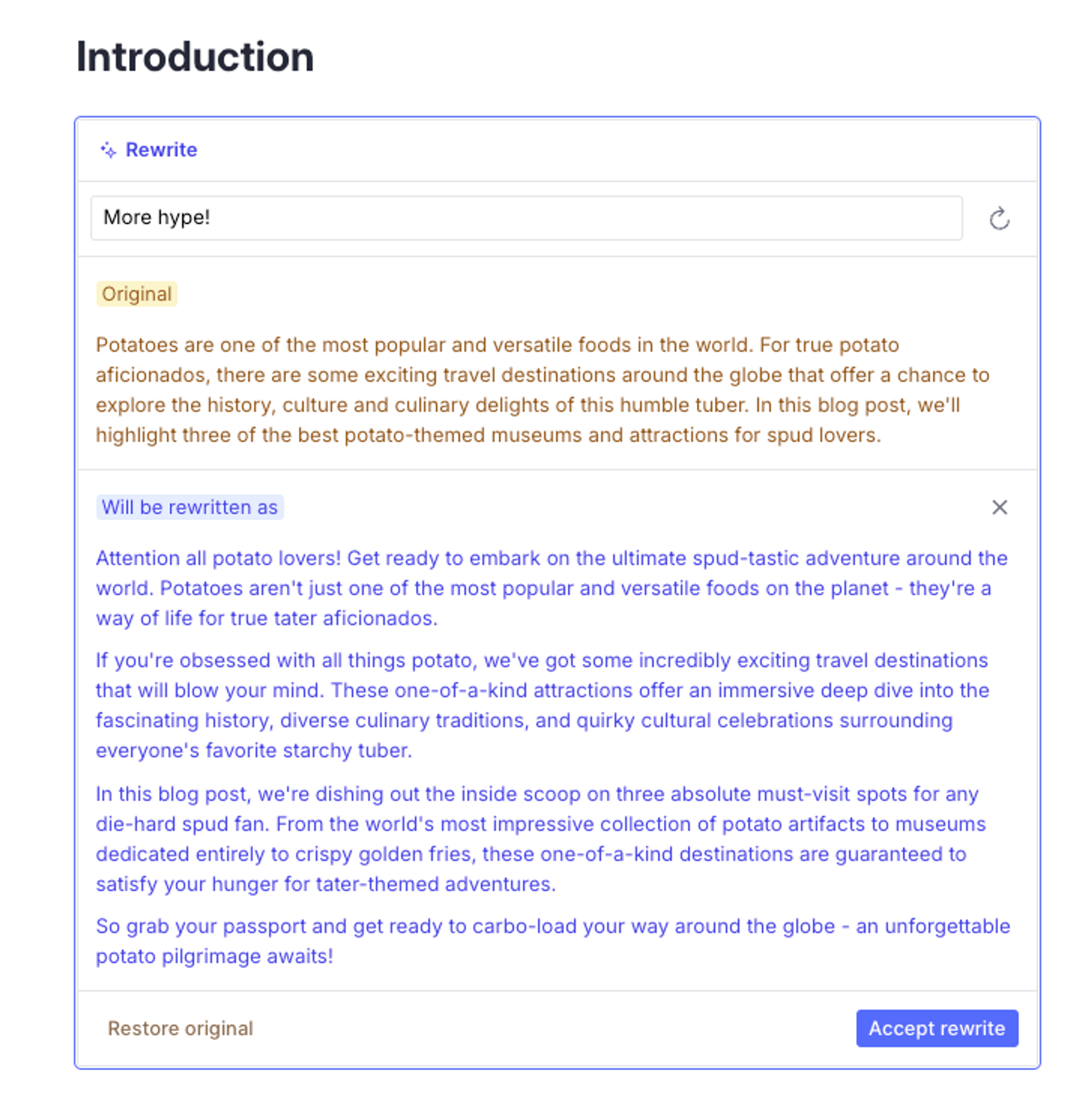
It's bots all the way down – AI assistant in notes
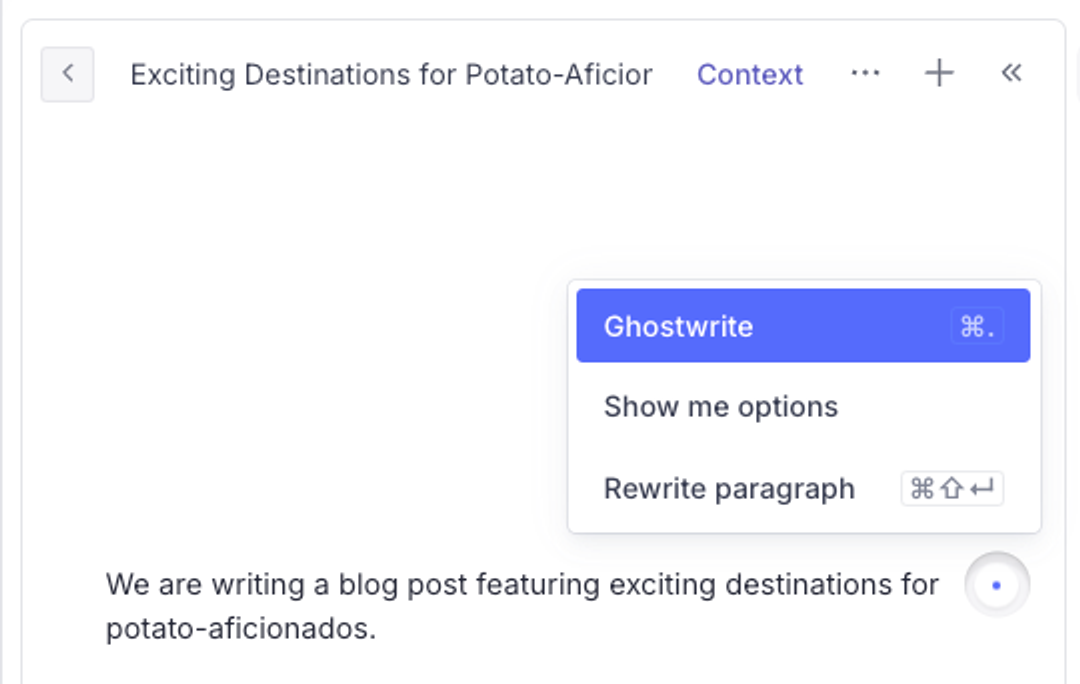
In addition to using the AI co-writer to help write your main document, you can also invoke it within individual notes for more targeted assistance.
You can select any text and hit CMD-Return to run the selected text as an instruction, or you can locate the Blip-button to access the same menu of options discussed in the previous section.
Some examples of instructions you could run inside a note:
- Summarize the key points of the note
- Identify any potential contradictions or inconsistencies
- Suggest additional facts or examples to include
- Rephrase the note in a different tone or style
- Answer a specific question based on the note's content
Once you submit your prompt, the ghostwriter will process the note and provide a response directly within the note editor. You can then choose to incorporate the ghostwriter's suggestions, modify them, or discard them as you see fit.
This in-note AI assistance can be incredibly useful when you need help refining or expanding on a particular piece of context without disrupting your main writing flow.
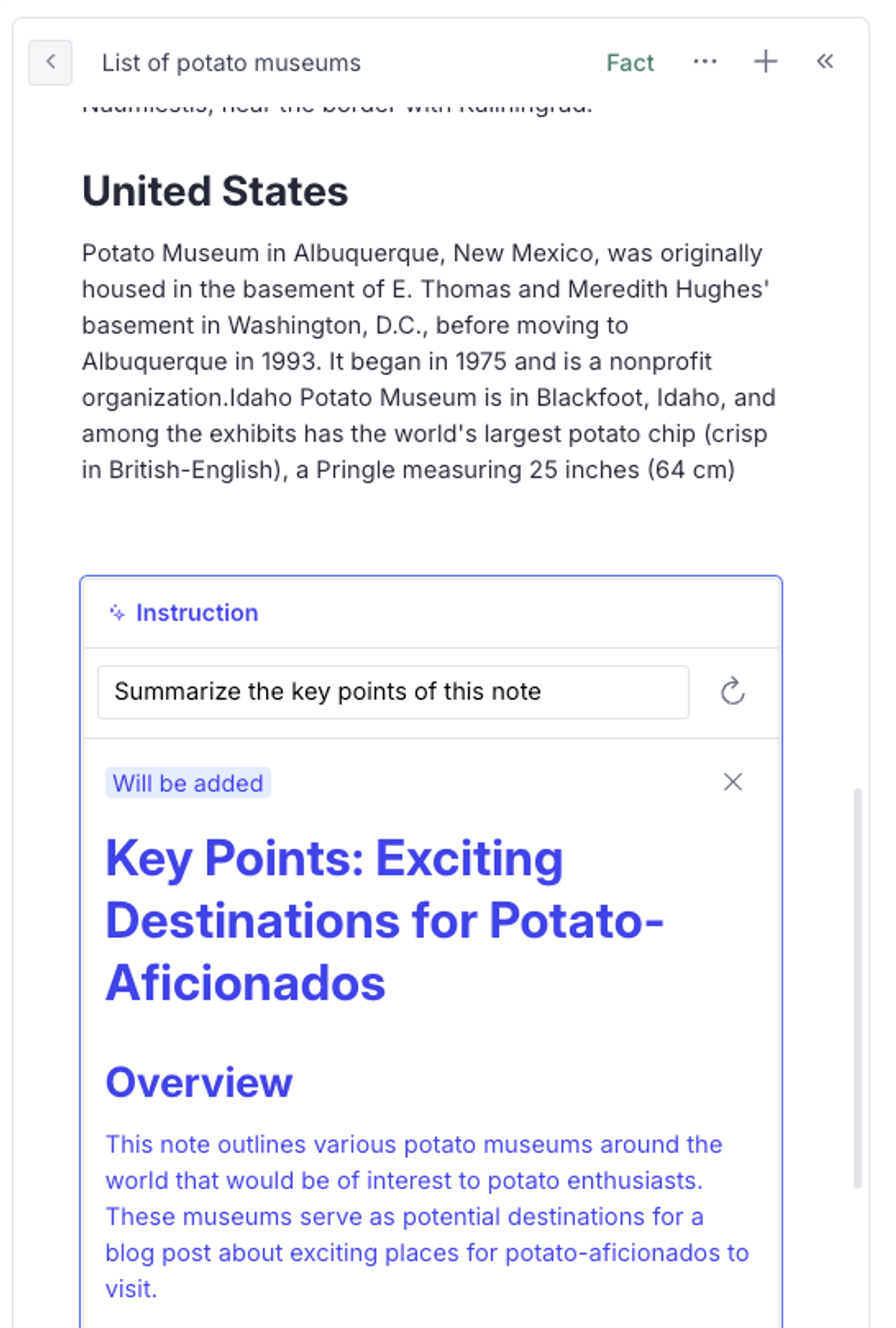
Best practices
- The more relevant and specific your notes, the better the AI can tailor its output to your needs
- Break down complex topics into smaller sections and use the AI to help flesh out each part
- Don't rely solely on the AI - review, edit, and add your own insights and perspective
- Experiment with different prompts and note combinations to find what works best for your writing style and goals
Was this page helpful?